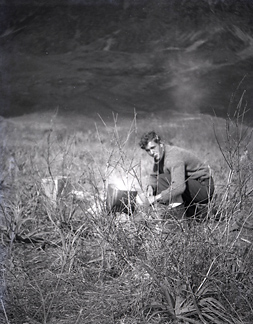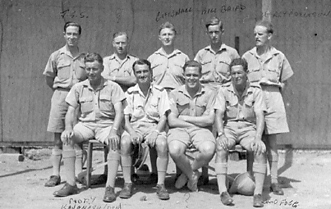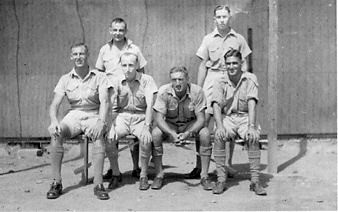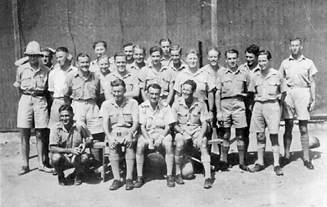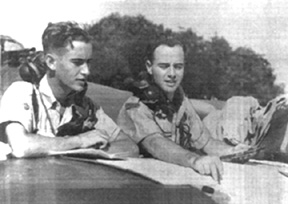 |
 |
||||||||||||||||||||||||||||||||||||||||||||||||||||||||||||||||||||||||||||||||||||||||||||||||||||||||
|
Sergeant W (Bill) Baird 653804 RAF Bill Baird grew up in Perthshire, at Blairgowrie. On the eve of war in August 1939, Bill left his employment as a legal apprentice to join the RAF. In September 1940, a Sergeant Wireless Operator Air Gunner, he was posted to 211 Squadron in the Western Desert. He was aged 19 in Greece.
Bill brews up on a sunny afternoon in camp at Paramythia. “We were like a lot of Boy Scouts!” said one of them wryly, much later. Indeed, a number of them had been, Gerry Martin and my own father included. Having survived both the Middle East and Greece, in the first Far East campaign Bill was in the last RAF party to leave Java in the face of the advancing Japanese, aboard RAFA Tung Song as it departed Tjilatjap bound for Fremantle on 2 March 1942. Bill celebrated his 21st birthday in Ceylon in May 1942 on joining 11 Squadron, still as Gunner to the boss, W/Cdr RN Bateson DFC. After the war, Bill headed straight for Blairgowrie and Janet. With the arrival of young Connor in 2002 they became the proud great-grandparents of the family Baird. He and Janet, married 63 years in February 2009, took much pleasure in their pretty garden and in frequent forays to the local golf courses. Bill took to the email age with amused enthusiasm, via a rather tricky text-only satellite TV service, his messages by that means being masterpieces of brevity. Later he was to tackle the PC world full-on, thanks to son Bill, and we were able to swap photographs of today and of the long ago with great enjoyment. Although as Bill used to say, tempus has definitely fugit, in his late 80s he kept a fine eye for detail and good recall that ever knew its limits. Allied with a terrific sense of humour and a kindly leg-pull or two, Bill was unfailingly helpful in responding to enquiries about 211 Squadron affairs from all and sundry, including me. His final gift to 211 Squadron came about in 2009. He and James Dunnet, both veterans of the air war in Greece, kindly added their names and signatures to a small run of beautiful commemorative certificates prepared by Ian and Victoria Carter for the Blenheim Society. To help in the ongoing effort to support the work of the Aircraft Restoration Co in returning a Blenheim to flight, the certificates were offered by the Society for sale with a newly-issued Corgi 1/72 scale 211 Squadron Mark I Blenheim of the period, with which Bill was quite impressed. Part of Bill Baird’s story is bound up with my that of my late father and with that of the late Jock Marshall DFM. Characteristically, Bill never sought a page of his own on site, so this is one page I’ve not sought permission for: it’s my thanks to Bill. Greece Jan 1941 “Date 6th Jan 41 A/c L1542 Sgt. Marshall Pilot, Sgt Richmond Observer, Sgt W Baird W/Op AG. On arrival at base Jock was astonished to see the extent of the damage - one could put head and shoulders through the hole. It took till the 16th to repair it! This ranks high in many near things that came my way, and makes me thankful that I survived to tell the tale. As for the delay factor and mechanism employed, I only know that when you heard the shells exploding, they were too near for comfort.” Palestine May 1941 Flying Log Book, W Baird, May 1941
In their close agreement with those in my Father’s Log Book, these entries helped to clarify the identity of some of the aircraft in use at the time. L4910 is a Mark I Blenheim, the others are Mark IVs. For 26 May, Bill Baird recorded the full aircraft serial as Z5818. In his own log, my father originally only recorded the last two digits of the serial (18), later transcribing a different aircraft identity altogether. Such details are often tricky. Other records show that although Z5818 had been lost with 82 Squadron on 2 April, Blenheim IV V5818 was indeed in the Middle East, reported missing on 28 May with Sgts Davis, Stalder and Trenholm—the Squadron’s last losses in action in the Middle East. The final May entry above refers to V5585. Bill remarked: “Two thoughts: Wadi Gazouza Bill pointed out the difficulties of personnel identification, which are not only due to the passing of the years. Officers and Sergeants, aircrew and groundcrew, each with their own tasks, associates, facilities and so on. It’s a tribute to the men, to their spirit, and a reflection of the morale of the Squadron in adversity that they kept together as well as they did and that so many of them recalled their mates and associates so well, for so long.
Faintly pencilled on the reverse in a neat confident hand “Sharratt” (JG, who is in shot), and in ink on its face with the names of 6 of the Sergeants present, as follows: L to R, back row: JG Sharratt, Sgt Inman, Gordon Chignall, W “Bill” Baird, Harry Callison (Sgt Armourer), then L to R, front row: Paddy Kavanagh DFM, nk [apparently F/Lt C Thomas RAF from the large group shot], nk [C “Harry” Briggs, also in the large group shot], W/O Fogg (Chief Armourer). These men are all experienced 211 Squadron aircrew turned instructor. A poignant shot: on 18 October, the well-liked Kavanagh was to die of natural causes.
Six RAAF WOp/AGs. The sun angle, the bench and placement details all show this photograph was taken on the same occasion as the shot above. None of these men went with 211 to the Far East. After seeing this photo enlarged, Bob Barclay in country Victoria recognised himself in shot and kindly checked his collection once more. Standing at the rear, L to R: Bill Godby, Noel Watt. Seated, L to R: Ron Gabrielson, Roy “Prairie” Flower, Bob Barclay, “Darky” Jennings. Bob Barclay was a WOp/AG on No 1 Blenheim Operations Course at Wadi Gazouza with 211 Squadron from June 1941 to November 1941, crewing up with old mate Geoff Furmage as pilot and Charlie Pailethorpe as Observer. Like Bill Baird and many others, he is correct in referring to them in those terms rather than as 72 OTU. In October 1941, Geoff, Charlie and Bob were posted as a crew to 45 Squadron, on Blenheim ops in the Western Desert and then in the Far East to stay with them until 1945. Bob’s own photos of this first course at Wadi Gazouza (not reproducible, unfortunately) included other RAAF men: Arch Fraser, Peter Haynes, Al Thomas, “Charger” Cameron, Doug Thornton, Theo Richards, Jack Nell, J Nankervis, and J Quirk.
Same time, same place. This print from Bill’s set eventually turned up in various sizes and conditions in several other collections, including that of Bob Barclay and JG Sharratt. Originally dated tentatively by Bill as November 1941 (putting it at the end of the No 1 Course), from the bench and shadow angles alone it seems most likely to have been taken on the same occasion as the preceding shots. The appearance of the men common to the three shots is identical down to hair-brushing level, as are irregularities in the cladding of the wall behind them. As Paddy Kavanagh is still present, the date seems likely to be in September or early October at the latest. Bill’s rear caption identified a number of the participants as follows, starting with the standing rank and reading from the right for once: JG Sharratt, second from the right & hands behind. Harry Callison Sgt Armourer, fifth from the right and to the rear. G Chignall sixth from the right and partly in front of Callison, Bill Baird seven from the right and behind Chignall. With face partly obscured, “Charger” Cameron is 11th from the right. Seated on the far left end of the bench with hands on knees is Paddy Kavanagh DFM with W/O Fogg seated far right. Bob Barclay’s collection includes the above photo but dated July 1941 (while another group clearly on the same day is dated June). A number of the No 1 Course RAAF men are in the above shot, for which Bob’s identification matches very well with Bill’s. Taken together, the RAF members and RAAF are clearly identified as follows. Back row (4): RM Barclay (hands behind head), J Nell, C. Cameron, N Watt Sumatra and Java “I was with 211 Squadron from Sep 1940 and served in the Western Desert, Greece, Syria, and as an instructor in The Sudan, training Australian aircrew. In Jan 1942 we re-formed in Egypt and left on our journey East on 14th Jan. [Bateson later recalled that the 24-strong Air Party as one Flight of six aircraft departing each day from 26 January to 29 January inclusive, while other log book accounts record that the actual dates were the four days 25 January to 28 January. Bill’s recall was otherwise in generally close accord with Bateson own narrative, which he only later received.] On the fateful 10th [of February 1942] in Z9649, we led S/Ldr Dundas and crew along with Sgt Paterson and crew to the target - Kluang. Take off around 0200. Our a/c was attacked by night fighters, and W/Cdr Bateson took massive evasive action and eventually succeeded in eluding them. Flying time 4 hours 40. On return to base we took off again at 0725, to search for missing a/c, but without success. I left Java on 2nd March, in Tung Song to Fremantle, thereafter to Ceylon where we took over Eleven Squadron. S/Ldr Dundas was my Flight Commander in Greece and was held in high regard by ground and aircrew alike. His next of kin had a letter from Air Ministry in London on 26th November, 1945, stating that his a/c which had been downed by ack ack, had been located, as well as the graves of his two Australian aircrew. No grave was found for him, however.” In a later note, Bill recalled the loss of Steele, Bott and their crews referred to in JB Keeping’s and in the Sumatra and Java narratives. 60 years later, Bill had a blunt view of the command requirement for that operation. “Lost while taking part of “fighter escort” to a convoy, thus demonstrating the Singapore thinking of so-called Higher Command. The same lot deemed that the Commanding Officer’s participation in raids should be restricted, contrary to 211 Squadron tactics of “follow the leader”. W/Cdr Bateson disagreed and arranged to have his Wingco pennant (tin!) attached to my aerial mast to draw attention to our status!” Flying Log Book, W Baird, 6 February to 18 February 1942
Notably, the records of Burrage, Cuttiford, Keeping and Penry at the time also agree that the convoy escort duty was on 7 February. Bateson himself recorded both dates. Contemporary and later records and many of the later accounts give either 6 February, or 7 February. It seems, on balance, that most (though not all) records nearest to the event refer to 7 February. Even where they exist, formal Squadron records, Log Books and diaries of the time are not always perfect. In their absence, less contemporary official records and later published accounts based on much later recall can present a rather muddled view of any period: the chaotic time in Sumatra and Java included. Thanks to Log Book contributions and similar personal records from men like Bill, it has now been possible to provide rather more accurate summaries of some of the events and losses of the first Far East campaign, although some differences in detail remain and are rather unlikely to be resolved. Bill’s last flight in the East Indies was that of 18 February, with CO Bateson. To Ceylon and 11 Squadron
Bill Baird on the left. A publicity shot, carefully posed, of Wireless Operator and Observer in a relaxed moment. The working photographer’s tricks of the trade have changed little in 80 years! From The Times of Ceylon Sunday Illustrated of October 18, 1942. Bateson himself kept prints of two other shots taken for the occasion. Bill’s remarks: “The photo was taken in Colombo, when I was asked (!) by WingCo Bateson to give an interview to the local reporter. The observer promoted by you to W/Cdr [now corrected] was in fact a P/O called in the article Ted, from Melbourne and who had been in shipping before joining the Air Force, presumably RAAF [...] (in Eleven Squadron at that time)”. This is a good object lesson of more than one sort. Firstly, it is all too easy to see what you want to see in photographs (or read what you want to read in documents). Something about the context and the Baird/Bateson association led me to “see” them both in the photo. Never mind that I couldn’t clearly count the braid rings on the P/Os shoulder tabs. Secondly, blunders need someone sharp enough to spot them, trouble to point them out, and come up with the right answer. Bill not only knew it wasn’t Bateson: he unearthed the original cutting and took the time to tell me so, with the result above. With 22 Squadron and after In March 1943 came the gazettal of his commission in the RAF as Pilot Officer—with effect from July 1942—and with it, posting to 22 Squadron. There were connections with the past: his new Squadron was still in Ceylon and equipped with Beauforts, a distant relative of the Blenheim. Not only that. Soon there were two Batesons listed as Pilot in the Baird Air Gunner’s Flying Log, the new CO being none other than W/Cdr JA Bateson, brother of his past CO RN Bateson DFC. Gazetted Flying Officer in May (effective January 1943), Bill soon received a quiet accolade: Mentioned in despatches 2 June 1943. He advanced to Flt Lt in July 1944, gazetted that August. Post-war, F/Lt Baird remained in the RAF for some years, with a stint in Shackletons (“10,000 loose rivets flying in close formation”) along the way. In March 1949, he transferred to the Reserve of Air Force Officers in the rank of Flight Lieutenant. A decade passed and then at long last, William Baird of Blairgowrie finally relinquished his commission. In private life Bill had taken up an occupation held by a number of other 211 Squadron personnel: he became a printer and so remained until his retirement some years ago. William Baird 1921—2010 It is with both great warmth and great sadness that I record the death of my friend William Baird in his 89th year, peacefully at Blairgowrie Cottage Hospital on Saturday 30 January 2010. Survived by his wife Janet and their children, grandchildren and great-grandchildren, he will be remembered aye with much affection. His shade now rests with his forebears; perhaps, betimes, with old comrades at ease among the olive groves in a land far away. Sources HMSO Air Force List issues 1943-1945 J Botwood The Avro Shackleton www.avroshackleton.com www.211squadron.org © D Clark & others 1998—2025 |
||||||||||||||||||||||||||||||||||||||||||||||||||||||||||||||||||||||||||||||||||||||||||||||||||||||||
